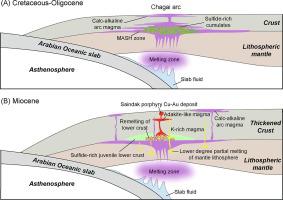Ore Geology Reviews ( IF 3.2 ) Pub Date : 2022-08-11 , DOI: 10.1016/j.oregeorev.2022.105062 Lu Wang , Yuanchuan Zheng , Zengqian Hou , Chuandong Xue , Zhusen Yang , Yang Shen , Xin Li , Abdul Ghaffar

|
The subduction-related Saindak porphyry Cu-Au deposit lies in the western segment of the Chagai belt, Pakistan. This deposit consists of three orebodies (south, east, and north), and each orebody is centered around ore-forming tonalite and crosscut by diorite porphyry dikes and andesite dikes. The three orebodies show similarities in the alteration zones, mineralization styles, and metallic associations. K-silicate, sericite-chlorite, quartz-sericite, and chlorite-epidote alteration assemblages are zoned around the porphyry intrusions. Laser ablation-inductively coupled plasma–mass spectrometry (LA-ICP–MS) U-Pb zircon geochronology yields ages between 22.2 ± 0.2 and 21.8 ± 0.3 Ma for the ore-forming tonalite, 22.1 ± 0.2 Ma for the diorite porphyry, and 22.2 ± 0.4 Ma for the andesite. Molybdenite re-Os dating yields an age of 22.2 ± 0.2 Ma for mineralization. The new geochemical compositions of magmatic rocks indicate that the andesite and K-rich diorite porphyry originated from partial melting of the asthenospheric mantle and metasomatized lithospheric mantle underneath the Chagai belt, respectively. The adakite-like ore-forming tonalites were derived from partial melting of a thickened juvenile lower crust, implying that the ore-forming materials in the Saindak deposit may be closely related to the lower crust. The injection of melts represented by the K-rich diorite porphyry would have increased the oxygen fugacity and water content of melts derived from the juvenile lower crust, making them favorable for the formation of the Saindak deposit. Combined with previously published data, we suggest that large porphyry Cu-Au deposits in the Chagai belt all developed in the thickened crust.
中文翻译:

巴基斯坦查盖带下方增厚的幼年下地壳重熔形成的与俯冲相关的山达克斑岩铜金矿床
与俯冲有关的山达克斑岩铜金矿床位于巴基斯坦查盖带的西段。该矿床由南、东、北三个矿体组成,每个矿体都以成矿英云长岩为中心,并被闪长斑岩岩脉和安山岩岩脉横切。这三个矿体在蚀变带、成矿方式和金属组合方面表现出相似性。钾硅酸盐、绢云母-绿泥石、石英-绢云母和绿泥石-绿帘石蚀变组合分布在斑岩侵入体周围。激光烧蚀-电感耦合等离子体质谱法 (LA-ICP-MS) U-Pb 锆石年代学得出的成矿英云雀年龄在 22.2 ± 0.2 和 21.8 ± 0.3 Ma 之间,闪长斑岩年龄在 22.1 ± 0.2 Ma 之间,而闪长斑岩年龄在 22.2 Ma 之间。安山岩为 ± 0.4 Ma。辉钼矿 re-Os 测年产生的年龄为 22.2 ± 0。2 Ma 用于矿化。岩浆岩的新地球化学成分表明,安山岩和富钾闪长斑岩分别起源于察盖带下软流圈地幔和交代岩石圈地幔的部分熔融。埃达克石状成矿云母岩来源于增厚的幼年下地壳部分熔融,暗示山达克矿床的成矿物质可能与下地壳密切相关。以富钾闪长斑岩为代表的熔体的注入将增加来自幼年下地壳的熔体的氧逸度和含水量,使其有利于山达克矿床的形成。结合此前公布的数据,


















































 京公网安备 11010802027423号
京公网安备 11010802027423号